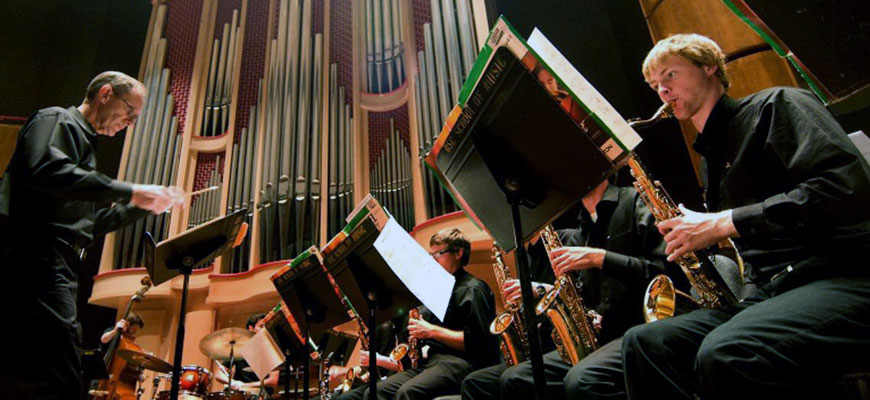
Music professor helps students discover new sounds, find their own voice
Visiting guitarist Jonathan Kreisberg exemplifies ever-evolving nature of jazz
Posted on: August 29, 2019; Updated on: August 29, 2019
By Josh German, mrassist@mailbox.sc.edu
“There is nothing in life that you can’t parallel with the tensions and volume and movement of music.” – Keith Jarrett, American jazz and classical music pianist/composer
Keith Jarrett's quote is music to the ears of Bert Ligon, director of jazz studies at the University of South Carolina. Jarrett's words embody Ligon's view on how a person feels when hearing the intricate, beautiful and challenging harmonies and rhythms that make up jazz.
Ligon has written four books, published several original compositions and arrangements, was nominated for an Emmy and won several PBS awards. He brings all that knowledge and expertise to jazz students in the School of Music.
The ultimate goal is that students can play what they hear and what they feel.
Bert Ligon, director of jazz studies
He says jazz is more of an experience than a passive act of listening. And for the musicians who play jazz, the music constantly evolves with each iteration as the performer seeks to improve upon their last rendition. Ligon himself would rather play jazz than listen — “just as I’d rather participate in a sport than watch," he says. "But what a joy it is to watch great athletes or listen to musicians who have spent so much time perfecting their craft."
Students, faculty and the community at large will get just such an opportunity on Sept. 5 with the performance of guitarist Jonathan Kreisberg, a musician and composer who embodies the ever-evolving nature of jazz. Combining timeless melodicism with forward-thinking textures, Kreisberg has toured the world both as a solo arist and with such artists as renowned Hammond B3 organist Lonnie Smith. Based in New York City, Kreisberg is regarded as one of the most compelling composer/performers in jazz. The concert starts at 7 p.m. in the School of Music Recital Hall and is free and open to the public.
“Jonathan Kreisberg is a very fluid guitarist with a colorful melodic and harmonic vocabulary," Ligon says. "He also digs deep into developing rhythmic motives and polyrhythmic playing. I hope the audience is swept away by any one of those elements and enjoys how the quartet interacts and reacts to each other’s playing.”
It's just this type of performance that exemplifies the university's commitment to providing music students with in-depth exposure to many different aspects of the music world. The benefits of such a performance, however, extend to both musicians and non-musicians.
“Part of listening is just to experience the pure art of the sound," Ligon says. "Part of it may also be trying to keep up with the artistic choices and logic and being surprised along the way. For musicians, too, we look for the inspiration and look forward to applying what we learn the next time we play.”
Today, jazz is widely embraced as a unique and iconic American art form. But Ligon recalls the early years, such as when a music education journal attacked the genre in the 1960s as "an art of vulgarity" that is "monotonous and pornographic" and “not a worthwhile educational project.” Even now, he says, the genre can still struggle within the world of music education to attract the attention of young musicians.
“I think high school students need more exposure to the music and the wide range of expression offered through jazz,” he says. “The ultimate goal is that students can play what they hear and what they feel. My hope is to give them a background and help them find what other great artists have heard and help them use that as a springboard for finding their own voice.”
Share this Story! Let friends in your social network know what you are reading about